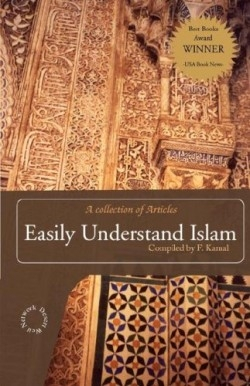Easily Understand Islam
A Collection of Articles
The basic tenets of Islam remain mysterious to many Americans despite the intense media focus on Muslims since September 11, 2001. Even fewer people are familiar with how mainstream Muslims view the Bible or how they apply the Quran and the Prophet Muhammad’s sayings to contemporary issues. This collection of essays addresses these topics with two audiences in mind: readers new to Islam, and Muslims seeking an informed Islamic perspective on the religion’s relevance for present-day problems. The editor (who holds degrees in engineering and business, and has studied Islam widely) brings together a volume that delivers more value to the latter group.
Because non-Muslims often fail to understand the basic elements of belief and practice that bind Muslims together, Kamal begins by tackling common misconceptions. He disputes, for example, the notion that the Prophet Muhammad wrote the Quran (which Muslims instead accept as divinely inspired). The five “pillars” of Islam, such as the requirement to pray five times a day, and other basic articles of faith receive succinct attention. Many previously published introductions to Islam do a better job covering these topics, but Kamal deserves credit for creating a solid common foundation for all readers, and including lists of Muslim virtues from the Quran and Muhammad’s sayings.
This book’s primary worth lies in the more adventurous chapters by other authors. In a chapter titled “The Quran and Modern Science,” Zakir Naik raises fascinating similarities between Quranic verses and developments in modern science, ranging from astronomy to zoology. As a case in point, he notes that the Quranic verse “And the earth, moreover, hath He made egg shaped” seems to describe the true shape of the planet even though flat-earth theories prevailed during the seventh century, when the Quran was revealed. Jerald Dirks provides another highlight in “Common Ground: Judaism, Christianity and Islam.” By comparing and contrasting the founding texts of these three faiths in a straightforward, easily digested account, Dirks goes a long way toward helping Muslims, Christians, and Jews understand both their shared tradition and their differences.
The contributors do not shy away from contentious topics: the book addresses inconsistencies in the Bible, logical difficulties with the Christian concept of the Trinity, and the opportunity for Islamic teachings to help address social problems in the United States. These chapters may appeal more to Muslims than to readers new to Islam.
By ambitiously aiming both to introduce Islam and to tackle difficult theological matters from an Islamic perspective, this book differentiates itself from many less demanding books about Islam. Those who seek only an introduction to the religion may be better off elsewhere, but readers eager to jump into more advanced treatments of Islam, its place in the monotheistic tradition, and its application to contemporary issues will find Easily Understand Islam a rewarding book, sure to spark new thoughts and vibrant discussions.
Reviewed by
David Priess
Disclosure: This article is not an endorsement, but a review. The publisher of this book provided free copies of the book to have their book reviewed by a professional reviewer. No fee was paid by the publisher for this review. Foreword Reviews only recommends books that we love. Foreword Magazine, Inc. is disclosing this in accordance with the Federal Trade Commission’s 16 CFR, Part 255.

